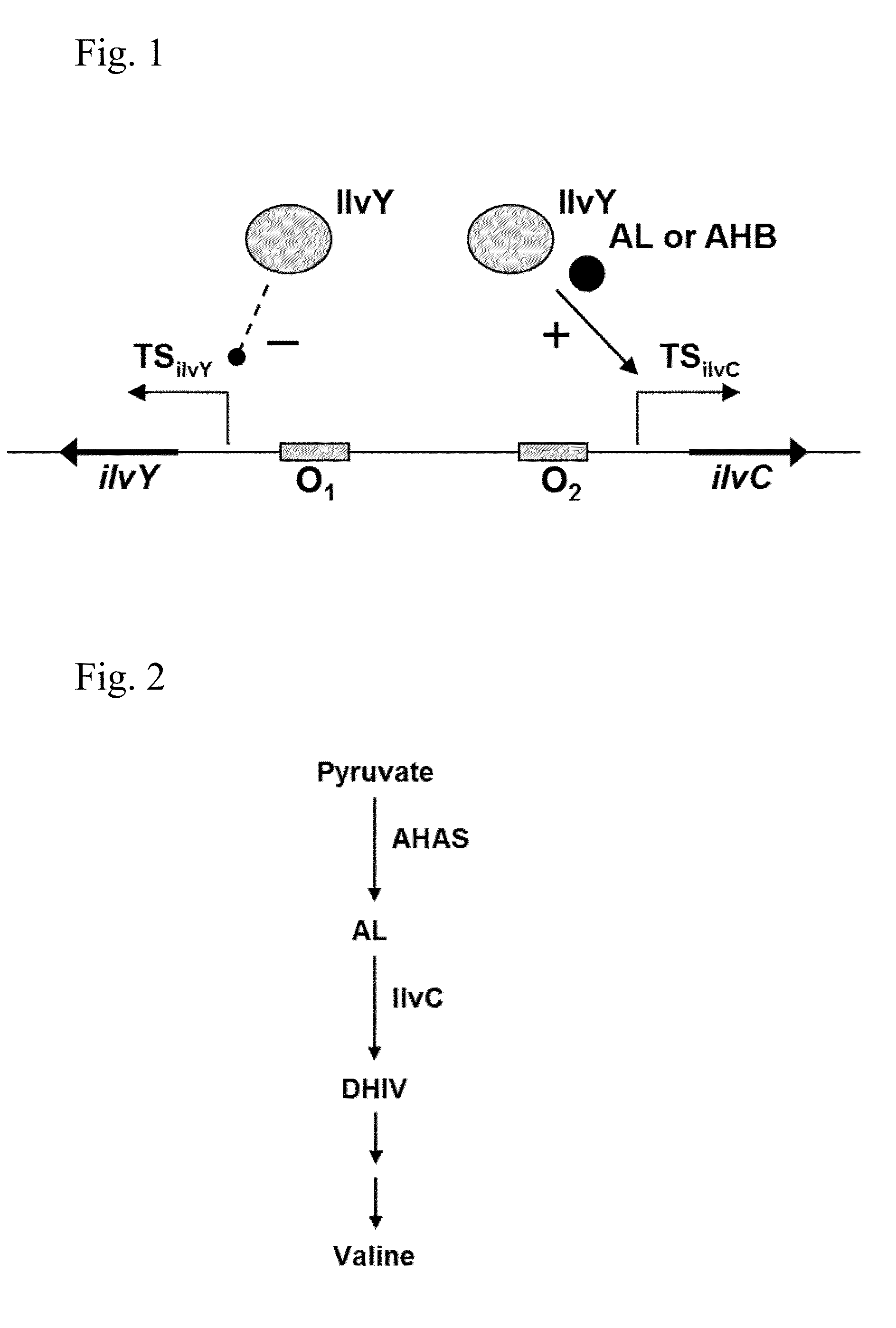Auto-Indicible Expression System, and the Use Thereof for Producing Useful Metabolites Using a Bacterium of the Family Enterobacteriaceae
a technology of auto-indicating expression and metabolites, which is applied in the field of microorganisms, can solve the problems of no data describing lysr-type protein-regulated gene(s) to da
- Summary
- Abstract
- Description
- Claims
- Application Information
AI Technical Summary
Benefits of technology
Problems solved by technology
Method used
Image
Examples
example 1
[0167]Construction of the acetohydroxy acids-regulated expression unit and analysis of its expression using the lacZ reporter gene under various genetic backgrounds
[0168]Transcription of the ilvYC genes has been well-characterized (Rhee K. et al., Proc. Natl. Acad. Sci. USA, 1999, 96(25):14294-14299; Opel M. L. and Hatfield G. W. Mol. Microbiol., 2001, 39(1):191-198). The possibility to use a promoter of the ilvC gene for metabolically-regulated expression system was studied. With this aim, firstly, the cat gene was introduced downstream of the ilvY gene on the chromosome of the E. coli MG1655 (ATCC 47076) strain using the λRed-mediated integration. The DNA fragment bearing λattL-cat-λattR cassette was amplified by PCR (polymerase chain reaction) using the oligonucleotide primers P1 (SEQ ID NO: 11) for ilvY-attL region and P2 (SEQ ID NO: 12) for attR-ilvY region, and the plasmid pMW118-λattL-cat-λattR (Katashkina Zh. I. et al., Mol. Biol. (Mosk.), 2005, 39(5):823-831) as the templat...
example 2
Construction of the Mutant E. coli B7 ΔilvGM ΔilvIH Cat-ilvY-PilvC-ilvBN4 Strain
[0176]The E. coli B7 ΔilvGM ΔilvIH PL-ilvBN4 strain was modified to contain the cat-ilvY-PilvC expression unit obtained as described in Example 1. The phage promoter PL upstream of the ilvBN4 genes was substituted for cat-ilvY-PilvC regulatory region using λRed-mediated integration in the E. coli B7 ΔilvIH ΔilvGM PL-ilvBN4 strain (construction of this strain is described in EP1942183). For this purpose, the DNA-fragment containing cat-ilvY-PilvC expression cassette flanked with the short regions adjacent to the ilvB gene was PCR-amplified using the oligonucleotide primers P7 (SEQ ID NO: 17) and P8 (SEQ ID NO: 18), and the chromosome of E. coli MG1655 cat-ilvY-PilvC-lacZ strain as the template. The PCR-fragment obtained was introduced by electrotransformation into the E. coli B7 ΔilvIH ΔilvGM PL-ilvBN4 / pKD46 strain as described above. As a result, the strain E. coli B7 ΔilvIH ΔilvGM cat-ilvY-PilvC-ilvBN4 ...
example 3
Properties of the mutant E. coli B7 ΔilvGM ΔilvIH cat-ilvY-PilvC-ilvBN4 strain
[0177]Cells were grown to the middle-logarithmic phase in M9:LB (9:1, v / v) medium supplemented with glucose (0.4%, w / v). Activity of AHAS I in crude cells extracts was measured with or without addition of 10 mM L-Val according to the assay described in Stormer F. and Umbarger H., Biochem. Biophys. Res. Commun., 1964, 17(5):587-592. The means of triplicate experiments are presented in Table 3. The data show that the cat-ilvY-PilvC regulatory region provides the increased level of AHAS I expression.
TABLE 3Activity of AHAS I measured in strains withcat-ilvY-PilvC-ilvBN4 expression unit.AHAS I activity, nmol / min*mgwith L-Val, 10 mMwithout(percent of value, measuredStrainL-Valwithout L-Val addition)B7 ΔilvGM ΔilvIH5951 (86%)PL-ilvBN4 (control)B7 ΔilvGM ΔilvIH9180 (88%)cat-ilvY-PilvC-ilvBN4 cl.1B7 ΔilvGM ΔilvIH121106 (88%) cat-ilvY-PilvC-ilvBN4 cl.4
PUM
| Property | Measurement | Unit |
|---|---|---|
| Acidity | aaaaa | aaaaa |
Abstract
Description
Claims
Application Information
 Login to View More
Login to View More - R&D
- Intellectual Property
- Life Sciences
- Materials
- Tech Scout
- Unparalleled Data Quality
- Higher Quality Content
- 60% Fewer Hallucinations
Browse by: Latest US Patents, China's latest patents, Technical Efficacy Thesaurus, Application Domain, Technology Topic, Popular Technical Reports.
© 2025 PatSnap. All rights reserved.Legal|Privacy policy|Modern Slavery Act Transparency Statement|Sitemap|About US| Contact US: help@patsnap.com

